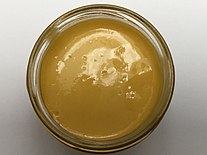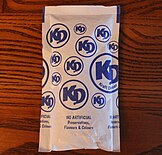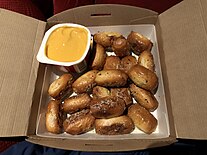 Broccoli with cheese sauce, at a restaurant in Semarang, Indonesia | |
| Alternative names | Cheese dip, cheese dipping sauce[1] |
|---|---|
| Serving temperature | Can be served cold, warm or hot |
| Main ingredients | Cheese, sometimes prepared using processed cheese, dried cheese, or cheese powder |
Cheese sauce is a sauce made with cheese or processed cheese as a primary ingredient. Sometimes dried cheese or cheese powder is used.[2][3] Several varieties exist and it has many various culinary uses. Mass-produced commercial cheese sauces are also made by various companies, in both liquid and dry forms. These prepared sauces are used by consumers and restaurants, and commercial formulations are used in the production of various prepared foods, such as macaroni and cheese mixes and frozen meals.
Varieties[edit]
Many sauces are prepared with cheese or processed cheese as the primary ingredient.
- Alfredo sauce – an American sauce inspired by Fettuccine Alfredo[4]
- Blue cheese dressing[5]
- Caruso sauce – a South American sauce[6]
- Cheddar sauce[7]
- Chile con queso – has a smooth, creamy texture, and is very popular in the American Southwest[8][9]
- Crab dip[10]
- Mornay sauce – a French sauce based on béchamel[11]
- Nacho cheese – an American processed cheese sauce[12]
Cheez Whiz is an American brand of processed cheese spread produced by Kraft Foods since the 1950s. It was developed as an easy way to prepare the sauce for Welsh rarebit. It was initially sold in glass jars, and today is sold in jars and spray cans. Cheez Whiz is commonly used for Philadelphia cheesesteak.[13]
- Varieties
-
An open jar of Cheez Whiz
-
Chili con queso with tortilla chips
-
Mornay sauce
Culinary uses[edit]


Cheese sauce is commonly used as a dip for various foods, such as chips and vegetables.[14] It is also used as an ingredient or topping for many various dishes and side dishes, such as sandwiches, roasted potatoes, casseroles, pasta dishes, egg, fish and meat dishes and in soups.[14][15]
Many dishes are prepared using cheese sauce:
- Almadroc[16]
- Cheese fries[17]
- Cheesesteak[18]
- Fettuccine Alfredo[4]
- Fondue – a Swiss melted cheese dish, the sauce typically consists of a blend of cheeses, wine, and seasoning[19][20]
- Horseshoe sandwich[21]
- Lokshen mit kaese[22]
- Macaroni and cheese[23]
- Nachos[24]
- Tetrazzini[25]
- Welsh rarebit – a dish of cheese sauce over toast, and sometimes the sauce itself[14]
Industrial products[edit]

Cheese sauce is a mass-produced product in the United States and other countries, such as China and Switzerland.[26][27] In the U.S., commercial preparations are available to consumers in grocery stores and are used in family-style, casual and fast food restaurants.[1][28][29]
Mass-produced cheese sauce is typically prepared aseptically and then packaged in sterile cans, bottles and bag-in-box containers.[30][31] Some varieties are sold in aerosol cans.[32] Commercial cheese sauces may be prepared using natural cheese, processed cheese, or both.[a] Various food additives and preservatives may be used in commercial preparations to create a uniform product that is consistent and stabilized in texture, consistency, color and flavor, to enhance flavor, and to ensure freshness.[15][34] Some additives and preservatives used may include carrageenan, citric acid, monosodium glutamate, sodium citrate, sorbic acid, and xanthan gum, among others.[15]
The industrial preparation and processing of liquid cheese sauces typically involve the shredding of bulk cheese products which is then placed en masse into a large processing container along with various dry ingredients and emulsifying salts.[15][35] The mixture is agitated to create a slurry, and is then aseptically treated using various machines to heat and sterilize the product and make it pourable, after which sterile bottles, jars or cans are filled with the product.[15] Such aseptically processed cheese sauces are typically shelf-stable, requiring no refrigeration until opened.[15]
Bag-in-box cheese sauces are typically used in retail environments and involve the use of connecting a bag of aseptically treated cheese sauce to a vessel that heats it and keeps it warm at a food-safe temperature.[31] A pump dispenser is used that delivers the sauce to various items, such as tortilla chips and sandwiches.[31][34]
Cheese sauces are also mass-produced in a powdered dry mix form.[36][37] These are produced as an instant food and purveyed to consumers in sauce mix packets and jars.[38] Dry mix packets are also provided in some dry macaroni and cheese products.[39][40]
Commercial frozen cheese sauce is used as an ingredient in prepared frozen meals and prepared frozen vegetables.[41][42] In some instances, particularly when a sauce has a high-fat content, the product may require emulsification to keep the product uniform and prevent it from separating.[41] Factors in frozen sauces such as their overall fat content and the size of particulates in them plays a role in how various frozen cheese sauces are formulated, cooked, treated and processed.[41]
Additionally, commercial cheese sauce formulations have been used as an ingredient in processed canned vegetables in the United States.[43][44]
Circa the later 2000s, the Campbell Soup Company began to modify its canned cheese sauce formulas based upon the company's perceived consumer preferences in various geographic regions in the United States.[45] The company concluded that the sauce was not considered hot enough (pungent) for average consumers in the American Southwest and West while being too hot for consumers in the Eastern United States.[45] At the time, to better serve its customer base, Campbell's began manufacturing a hotter product in their California and Texas plants compared to their other plants.[45]
In July 2018, Kraft Heinz issued a voluntary nationwide product recall in the United States of around 100,000 jars of cheese dip,[46][47] due to a potential for the growth of Clostridium botulinum because of ingredient separation.[47] It was only distributed in the United States, and consumers were advised not to eat it, even if it lacked signs of spoilage.[47][48]
- Commercial cheese sauces
-
Kraft Dinner is packaged with a processed powdered cheese sauce packet (Canada, 2018).
-
A serving of macaroni and cheese included as part of a frozen meal with frozen cheese sauce as an ingredient
-
Pretzel bites with a commercial cheese sauce at a movie theater in the United States
See also[edit]
- Cheese soup
- Easy Cheese
- List of cheese dishes
- List of sauces
- Pimento cheese – a cheese-based spread
Notes[edit]
References[edit]
- ^ a b Green, Dennis (24 February 2019). "Chick-fil-A sells a cheese dipping sauce in certain parts of America – here's what the rare side tastes like". Business Insider. Retrieved 3 November 2021.
- ^ Celigueta Torres, Isabel; Ispen, Richard Ipsen1; Kjær Beck,Tove (2008). "Rheology and Functionality of Cheese Powders". Annual Transactions of The Nordic Rheology Society. Vol. 16. Retrieved 4 November 2021.
- ^ Guinee, Timothy P.; O'Brien, Niamh B.; Rawle, Donal F. (1994). "The viscosity of cheese sauces with different starch systems and cheese powders". International Journal of Dairy Technology. 47 (4). Wiley: 132–138. doi:10.1111/j.1471-0307.1994.tb01535.x. ISSN 1364-727X.
- ^ a b Bein, Ken (19 May 2021). Weekly Recipe: "Alfredo Sauce Three Ways by Joshua Weissman". Gotham. Retrieved 4 November 2021.
- ^ Weagant, Stephen D.; Bryant, James L.; Bark, Don H. (1 June 1994). "Survival of Escherichia coli O157:H7 in Mayonnaise and Mayonnaise-Based Sauces at Room and Refrigerated Temperatures". Journal of Food Protection. 57 (7): 629–631. doi:10.4315/0362-028X-57.7.629. ISSN 0362-028X. PMID 31121702. Retrieved 4 November 2021.
- ^ Allen, Gary (2019). Sauces Reconsidered: Après Escoffier. Rowman & Littlefield Studies in Food and Gastronomy. Rowman & Littlefield Publishers. p. 156. ISBN 978-1-5381-1514-5. Retrieved 4 November 2021.
- ^ Rodgers, R.; Williams, C.; Thomas, M. (2005). Sauces, Salsas & Relishes. Williams Sonoma mastering. Free Press. p. 63. ISBN 978-0-7432-6737-3. Retrieved 4 November 2021.
- ^ Brownstone, Cecily (27 June 1972), "Chili con Queso Tasty Dip", Spokane Daily Chronicle, p. 27, retrieved 22 March 2011
- ^ Restaurant Business. Restaurant Business. 1997. p. 160. Retrieved 3 November 2021.
- ^ Heuck, Lidey (11 August 2020). "Baked Crab Dip With Old Bay and Ritz Crackers Recipe". NYT Cooking. Retrieved 4 November 2021.
- ^ Peterson, J. (2017). Sauces: Classical and Contemporary Sauce Making. Houghton Mifflin Harcourt. p. 137. ISBN 978-0-544-81982-5. Retrieved 4 November 2021.
- ^ Herrera-Sobek, M. (2012). Celebrating Latino Folklore: An Encyclopedia of Cultural Traditions [3 volumes]: An Encyclopedia of Cultural Traditions. ABC-CLIO. p. 826. ISBN 978-0-313-34340-7. Retrieved 4 November 2021.
- ^ Donnelly, C.W. (2016). The Oxford Companion to Cheese. Oxford Companions. Oxford University Press. p. 160. ISBN 978-0-19-933088-1. Retrieved 4 November 2021.
- ^ a b c Strong, Rebecca (6 October 2021). "How to make a creamy cheese sauce that goes great on anything". Insider. Retrieved 3 November 2021.
- ^ a b c d e f Chandan, R.C.; Kilara, A. (2010). Dairy Ingredients for Food Processing. Wiley. pp. 491–493. ISBN 978-0-470-95912-1. Retrieved 3 November 2021.
- ^ Song, H.R.; Riera, A. (2019). A Taste of Barcelona: The History of Catalan Cooking and Eating. Big City Food Biographies. Rowman & Littlefield Publishers. p. 57. ISBN 978-1-5381-0784-3. Retrieved 4 November 2021.
- ^ Kenji López-Alt, J. (17 September 2010). "Cheese Sauce for Cheese Fries and Nachos Recipe". Serious Eats. Retrieved 4 November 2021.
- ^ Carman, Tim (12 January 2021). "Why the Philly cheesesteak gives us hope during a pandemic". Washington Post. Retrieved 3 November 2021.
- ^ Handbook of molecular gastronomy : scientific foundations and culinary applications. Róisín Burke (First ed.). Boca Raton, FL. 2021. ISBN 978-0-429-16870-3. OCLC 1226076171.
{{cite book}}: CS1 maint: location missing publisher (link) CS1 maint: others (link) - ^ Kelly, Melissa (February 1998). "Classic Swiss Cheese Fondue Recipe". Food & Wine. Retrieved 4 November 2021.
- ^ Willett-Wei, Megan; McDowell, Erin (3 November 2021). "The most famous local sandwich from every state". Business Insider Australia. Retrieved 4 November 2021.
- ^ "Move Over, Ricotta. This Pasta Gets Its Creaminess From Cottage Cheese". The New York Times. 28 May 2021. Retrieved 4 November 2021.
- ^ Thompson, Kat (11 March 2021). "Simmer Down: How to Conquer Cheese Sauce for a Perfect Mac 'n Cheese". Thrillist. Retrieved 3 November 2021.
- ^ Cain, Brenda (23 July 2020). "Ranking 12 nacho cheese sauces to eat while watching the Cleveland Indians". cleveland. Retrieved 3 November 2021.
- ^ Sifton, Sam (2 October 2016). "Chicken Tetrazzini Recipe". NYT Cooking. Retrieved 4 November 2021.
- ^ PeiPei, Wei; WeiFeng, Lin; Zhong, Chen (2009). "Preparation of Chinese cheese sauce". Modern Food Science and Technology. 25 (10): 1190–1192. Retrieved 3 November 2021.
- ^ USITC Publication. Annual report – United States International Trade Commission. U.S. Government Printing Office. 1982. p. 51. Retrieved 3 November 2021.
- ^ Juneja, V.K.; Sofos, J.N. (2001). Control of Foodborne Microorganisms. Food Science and Technology. CRC Press. p. 326. ISBN 978-1-4822-7091-4. Retrieved 3 November 2021.
- ^ Davis, A.A. (2015). America's Best BBQ: 100 Recipes from America's Best Smokehouses, Pits, Shacks, Rib Joints, Roadhouses, and Restaurants. Andrews McMeel Publishing. p. 148. ISBN 978-1-4494-6976-4. Retrieved 3 November 2021.
- ^ Richardson, P. (2008). In-Pack Processed Foods: Improving Quality. Woodhead Publishing Series in Food Science, Technology and Nutrition. Elsevier Science. p. 256. ISBN 978-1-84569-469-2. Retrieved 3 November 2021.
- ^ a b c David, J.R.D.; Graves, R.H.; Szemplenski, T. (2012). Handbook of Aseptic Processing and Packaging. CRC Press. p. 24. ISBN 978-1-4398-0720-0. Retrieved 4 November 2021.
- ^ Agriculture, Rural Development, and Related Agencies Appropriations for Fiscal Year 2001. S. hrg. U.S. Government Printing Office. 2001. Retrieved 3 November 2021.
- ^ Tamime, A.Y. (2011). Processed Cheese and Analogues. Society of Dairy Technology. Wiley. p. 7. ISBN 978-1-4443-4183-6. Retrieved 3 November 2021.
- ^ a b Scott, Megan (7 July 2020). "The Real Reason You Should Never Order Arby's Cheddar Cheese Sauce". Mashed.com. Retrieved 4 November 2021.
- ^ Szafrańska, Jagoda O.; Sołowiej, Bartosz G. (2020). "Cheese sauces: Characteristics of ingredients, manufacturing methods, microbiological and sensory aspects". Journal of Food Process Engineering. 43 (4). Wiley. doi:10.1111/jfpe.13364. ISSN 0145-8876. S2CID 213369294.
- ^ Aramouni, F.; Deschenes, K. (2014). Methods for Developing New Food Products: An Instructional Guide. DEStech Publications, Incorporated. p. 95. ISBN 978-1-60595-112-6. Retrieved 3 November 2021.
- ^ Childs, Jessica L.; Yates, Michele D.; Drake, MaryAnne (2009). "Sensory Properties and Consumer Perception of Wet and Dry Cheese Sauces". Journal of Food Science. 74 (6). Wiley: S205–S218. doi:10.1111/j.1750-3841.2009.01187.x. ISSN 0022-1147. PMID 19723225.
- ^ Engelbreit, M. (2010). Mary Engelbreit's Fan Fare Cookbook: 120 Family Favorite Recipes. Andrews McMeel Publishing. p. 62. ISBN 978-0-7407-7969-5. Retrieved 3 November 2021.
- ^ Denenberg, Zoe (6 October 2021). "10 Easy Ways to Upgrade a Box of Mac and Cheese". Southern Living. Retrieved 3 November 2021.
- ^ Matthews, Susan (14 July 2017). "No, Boxed Mac and Cheese Is Not "Toxic"". Slate Magazine. Retrieved 3 November 2021.
- ^ a b c Mallett, C.P. (1993). Frozen Food Technology (in Basque). Springer US. p. 278. ISBN 978-0-7514-0072-4. Retrieved 3 November 2021.
- ^ Boye, J.I.; Arcand, Y. (2012). Green Technologies in Food Production and Processing. Food Engineering Series. Springer. p. 447. ISBN 978-1-4614-1586-2. Retrieved 3 November 2021.
- ^ Huang, T.T. (1968). Utilization of Butter and Cheese in Canned Vegetables. University of Wisconsin—Madison. p. 7. Retrieved 3 November 2021.
- ^ Weckel, K.G.; Huang, T.T. (1968). Processing Canned Vegetables in Butter and Cheese Sauces. Research report (University of Wisconsin—Madison. College of Agricultural and Life Sciences. Research Division). Research Division, College of Agricultural and Life Sciences, University of Wisconsin. Retrieved 3 November 2021.
- ^ a b c Sun, Shili (2009). "An Analysis on the Conditions and Methods of Market Segmentation". International Journal of Business and Management. 4 (2): 63–70. doi:10.5539/ijbm.v4n2p63.
- ^ "Taco Bell cheese dip recalled due to botulism risk". CBS News. 25 July 2018. Retrieved 3 November 2021.
- ^ a b c "Kraft Heinz Co. recalls Taco Bell cheese sauce for botulism risk". Food Safety News. 26 July 2018. Retrieved 3 November 2021.
- ^ Mikkelson, David (26 July 2018). "Taco Bell Cheese Dip Recalled Due to Botulism Risk". Snopes. Retrieved 3 November 2021.
Further reading[edit]
- Li, Lei; Singh, Rakesh K.; Lee, Jun Ho (1 July 2004). "Process conditions influence on characteristics of holding tube fouling due to cheese sauce". LWT – Food Science and Technology. 37 (5): 565–572. doi:10.1016/j.lwt.2004.01.002. ISSN 0023-6438. Retrieved 3 November 2021.
- West, Ryan; Seetharaman, Koushik; Duizer, Lisa M. (1 July 2013). "Whole grain macaroni: Flavour interactions with sodium-reduced cheese sauce". Food Research International. 53 (1): 149–155. doi:10.1016/j.foodres.2013.04.002. ISSN 0963-9969. Retrieved 3 November 2021.
- Carroll, Linda (17 July 2017). "How harmful are the chemicals in your boxes of mac and cheese?". Today. Retrieved 3 November 2021.
- Marsili, R. (2006). Sensory-Directed Flavor Analysis. Food Science and Technology. CRC Press. pp. 210–214. ISBN 978-1-4200-1704-5. Retrieved 3 November 2021.
- Szafrańska, Jagoda O.; Sołowiej, Bartosz G. (2020). "Cheese sauces: Characteristics of ingredients, manufacturing methods, microbiological and sensory aspects". Journal of Food Process Engineering. 43 (4). Wiley. doi:10.1111/jfpe.13364. ISSN 0145-8876. S2CID 213369294.
- Townes, John M. (1 September 1996). "An Outbreak of Type A Botulism Associated with a Commercial Cheese Sauce". Annals of Internal Medicine. 125 (7). American College of Physicians: 558–563. doi:10.7326/0003-4819-125-7-199610010-00004. ISSN 0003-4819. PMID 8815754. S2CID 15632246.
External links[edit]
 Media related to Cheese sauce at Wikimedia Commons (Category page)
Media related to Cheese sauce at Wikimedia Commons (Category page) Media related to Cheese sauce at Wikimedia Commons (General search)
Media related to Cheese sauce at Wikimedia Commons (General search)






